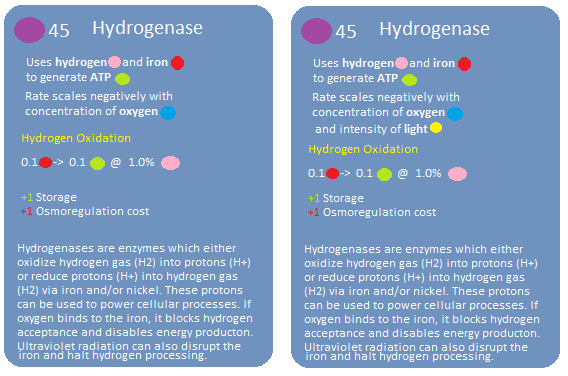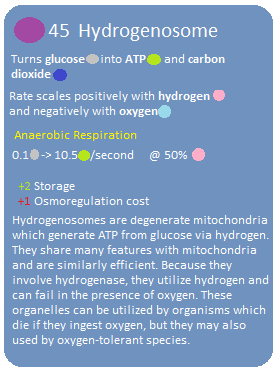In the shoutbox I asked about hydrogen metabolism, and Hhyyrylainen responded in the quick question thread by saying that he didn’t know about the topic. I responded with a lot of links, and meanwhile I read more information and created two concepts for an organelle I hope to see added to the game (alongside another atmospheric gas).

This is hydrogenase, an enzyme used by many microorganisms to oxidize or reduce hydrogen. Oxidation is what I am interested in here. Before the photosynthesizers changed Earth’s atmospheric composition, there was much more hydrogen in the atmosphere and oceans. This hydrogen was used by anaerobic organisms to generate energy. They were and are autotrophs and can form the basis of ecosystems. They are the plankton of an anaerobic world.
Hydrogen gas is two hydrogen atoms, and hydrogenase basically snaps them apart and uses the energy from that to drive cellular processes. At the center of hydrogenases (there are many) is either iron, nickel, or both, which means that the iron already in the game could be made more useful. The hydrogen is produced by nitrogenase, which is already in the game. As such, the addition of hydrogen as an atmospheric gas is overdue, I think. Nitrogenase should consume hydrogen sulfide and generate hydrogen gas as a byproduct, and hydrogenase should take that hydrogen gas and make ATP. Technically hydrogenases do not produce ATP, but rather NADP. However, I think this simplification is acceptable due to Thrive needing to be a fun video game. Also, iron is a catalyst in the reaction and is not consumed, but my concept has it being consumed in a small amount in order to create more interactions with iron. Besides, hydrogen-oxidizing bacteria do need to consume iron to begin the process.
Notice that the rate of ATP production in my concepts scales negatively with oxygen concentration. This is because oxygen binds to the iron and blocks hydrogen, thereby stopping energy production. Ultraviolet radiation messes with it too, but I was uncertain if having two negative modifiers would be any fun, so I made two concepts (one with lux and one without). I was uncertain how to represent a negative modifier in the equation part. I think this negative interaction would make the game much more interesting. I had difficulty finding any numbers for the efficiency of hydrogen oxidation. The only number I could find was 10,000 H+ per second.
Here are two sources which contain far more than enough information for Thrive about hydrogenase
https://www.sciencedirect.com/science/article/pii/S000527281300025X
https://www.sciencedirect.com/topics/engineering/hydrogenase
Here is a eukaryotic counterpart to hydrogenase: the hydrogenosome.

This thing is a degenerate mitochondrion that lost the ability to function in oxygen and instead utilizes hydrogenase (and lots of other things that are too specific for Thrive). This means that anaerobes can have a powerhouse too! Almost all the species which use these are unicellular, though there are a few subterranean animals which are entirely anaerobic; they die in the prescence of oxygen and rely on hydrogenosomes like we rely on mitochondria. The hydrogenosome could also be used by a species which only occasionally lives in anoxic environments or lives on the border between oxygen and not-oxygen.